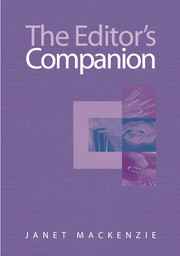Book contents
- Frontmatter
- Contents
- List of illustrations
- Preface
- 1 The editor in context
- 2 The publishing process
- 3 Management and liaison
- 4 Substance and structure
- 5 Language
- 6 Illustrations and tables
- 7 Completeness and consistency
- 8 Proofs
- 9 Editing methods
- 10 Working with documents and files
- 11 Freelance editing
- Appendix: Australian Standards for Editing Practice
- Notes
- Select bibliography
- Index
6 - Illustrations and tables
Published online by Cambridge University Press: 05 June 2012
- Frontmatter
- Contents
- List of illustrations
- Preface
- 1 The editor in context
- 2 The publishing process
- 3 Management and liaison
- 4 Substance and structure
- 5 Language
- 6 Illustrations and tables
- 7 Completeness and consistency
- 8 Proofs
- 9 Editing methods
- 10 Working with documents and files
- 11 Freelance editing
- Appendix: Australian Standards for Editing Practice
- Notes
- Select bibliography
- Index
Summary
Because editors tend to focus on words, they may fail to appreciate the power of graphics to convey information. Collaboration with designers can provide an education and enlarge your view of what is possible. In heavily illustrated publications–coffee-table books, annual reports, art catalogues and even cook books–the pix take precedence over the text. Their production requires close liaison between the editor and the designer throughout the project.
The term ‘illustrations’ covers a wide range of material, defined in Standard D as including drawings, cartoons, diagrams, charts, graphs, maps, photographs, computer-generated graphics and moving images (see Appendix). Here we will look at the editor's tasks. For more information, see the Style Manual, Chapter 21.
Appraising pix
Pix appear on your desk in various physical manifestations–boxes of slides, rough sketches, printouts of scanned photographs, computer-drawn graphs. When working with photographs and drawings, use photocopies or printouts; this saves the originals from harm and also allows you to freely mark crop lines and other instructions for the designer. The edited photocopies are known as artwork roughs. Store original artwork and photographs safely and return them, carefully packaged, with the edited manuscript.
Your first task is to scrutinise the pix in the same way you do all elements of the manuscript: is this pic really necessary, is it suitable for the intended reader, does it serve the purpose? In addition, consider its visual impact and quality and imagine how it will look when reproduced, possibly at a much smaller or larger scale.
- Type
- Chapter
- Information
- The Editor's Companion , pp. 95 - 107Publisher: Cambridge University PressPrint publication year: 2004



